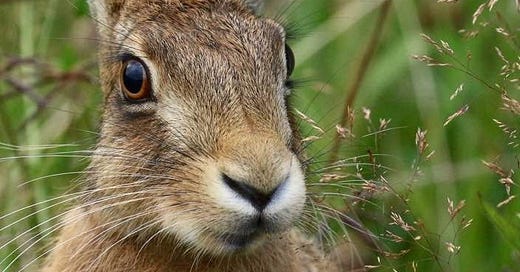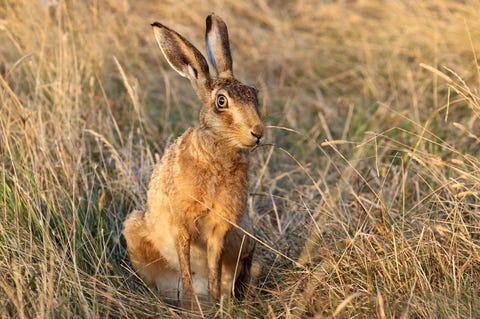This is the Wilderness We Choose, our Lenten journey day 35 is for the hare, who we will hear much more of, together with their protector saint, Melangell, when Maytide comes I am sure.
But, for now, it feels right to have a little introduction to hares, so deeply woven in are they with the folklore of Easter and springtime.
The European brown hare is native to the European continent & parts of Asia. It's often said that the species was introduced to Britain by the Romans but recent work by the Universities of Exeter, Leicester, & Oxford suggests that they arrived even earlier as an Iron Age introduction between the 3rd & 5th century BCE.
Hares are generally shy & mostly emerge to forage only at night. In spring it's different & they can be seen chasing one another during daylight. Occasionally, a female will see off a male or test his tenacity by 'boxing' with him. No wonder that the hare is so deeply intertwined with women, femininity, female deities, women's hedgerow practices, & the cycles of the moon.
Between
I find hare´s moult beneath the holly.
Where other trees bare
their death angles quietly,
holly shuns with wide awake thorns.
The hare, she leaves parts of herself
everywhere she goes,
winter’s soft white blanket,
she births herself
spring, summer, then witch.
She already burns,
a shocking heat tucked away,
redness in the pit of her like a bite,
fur is ruins smoking.
Her paws are cold star-fire.
At dawn, she learns to box without gloves.
Cleft lipped witch shafts herself
leaping broom,
in the slick of morning,
sheds her old body,
licks it off herself,
tongue clogged with
all the demands made of it.
I know the woman that walks
out of the wood in the evening,
she is the woman the little wren
inflates with song for,
the fox leaves his gifts on the path for her,
acorns split to show her their red inner meat.
Her lips are still velvet.
*Susannah Violette
In his book, ‘The Private Life of the Hare’, John Lewis-Stempel writes of his first close encounter with a hare when he was around the age of seven. It begins as the young Lewis is in his bathroom washing his face with a flannel to get ready for school. Out of the window, he saw a hare and, because the house was on a steep slope, the hare was almost at eye level. For a few minutes, “the big hare and the small boy washed on opposite sides of the glass,” but then, it bolted;
“No longer was the hare and enchanting friend; it became absolute motion, a process in physics, a kinetic event. Every cell of the hare was energy as it travelled across the earth. Hares have no home. Rabbits when threatened make for their burrows, blackbirds dive into thickets. Hares run fast for their lives. I have seen many hares since, but the hare in the wheat field at Withington was the one which showed me that hares, unique among the animals, can alter state.”
Truly, there is something visceral, and yet deeply otherworldly, about the hare.
And hares really can ‘run fast for their lives’. They are able to reach speeds of up to 48 mph, making them the fastest land mammal in Britain. They can jump over 10 feet in a single bound. No wonder then that the hares Latin name is Lepus, meaning ‘light-foot’.
The discovery of hare skeletons, buried individually & with care, offers evidence that hares weren't eaten here until the arrival of the Romans. Rather, they were considered supernatural beings associated with an unknown female hare deity, although Bede’s assertion that the Anglo-Saxon’s named April ‘Eosturmonath’ after an Anglo-Saxon deity named ‘Eostre’, who has become associated with the dawn, hares, and eggs, is a matter of heated debate.
In Northern Europe, Easter imagery often includes hares and rabbits. Charles J. Billson, in his late 19th-century study of the hare in folk custom and mythology, described a number of folk customs involving hares around the Easter season in Northern Europe. He wrote that, "whether there was a goddess named Ēostre, or not, and whatever connection the hare may have had with the ritual of Saxon or British worship, there are good grounds for believing that the sacredness of this animal reaches back into an age still more remote, where it is probably a very important part of the great Spring Festival of the prehistoric inhabitants of this island."
Certainly hares were considered special by our ancient ancestors. Julius Caesar's De Bello Gallico says: "The Britons consider it contrary to divine law to eat the hare." In Ireland, it was said that eating a hare was like eating your own grandmother.
But, aside from their magical and folkloric associations, there are three things about hares that I find compelling and meaningful; all three grounded in their natural behaviour and physiology. All three strip hare back to her essence. This is the invitation of Lent.
Firstly, as mentioned above, hares, unlike rabbits, do not dig burrows for protection but are surface dwellers. During the day, they sleep on the ground in depressions known as ‘forms’. That these forms so closely resemble lapwing nests is possibly one of the reasons why hares came to be associated with the laying of eggs. These forms are carefully chosen to allow the hare a good view and the scent of any interlopers.
And Jesus said to him, “Foxes have holes, and birds of the air have nests, but the Son of Man has nowhere to lay his head.” (Luke 9:58)
I find the hare’s trust in the earth beneath her feet moving and comforting. When I have felt my material comfort in jeopardy, I have often thought of the hare and her form.
Secondly, I was enchanted to learn that the hare’s heart is disproportionately large in comparison to other mammals, weighing between 1 and 1.8% of their body weight (a rabbit’s heart weighs approximately 0.3%). This huge heart is the key to the hare’s ability to move with such speed, described by John Lewis-Stempel as their ‘secret engine’. But it is this great heart as a symbol of compassion that I find so powerful. On Old Twelfth Night, 18th January 2022, my spiritual community, the Wild Goose Collective, envisioned the ‘Hare-hearted Chapel of St Melangell’, where we can bring our sorrows, our vulnerabilities, and our brokenness. There is nothing that a heart willing to expand beyond breaking can’t heal.
Jesus wept. (John 11:35)
And thirdly, the hares broad nose hides turbinate bones, ‘thin and delicate as glass’, which enable the hare to maximise oxygen intake. They know how to breathe deeply and how to allow the air they breathe to reach their deepest centre. In this overwhelming world, where we find that we often forget to breathe, they are a valuable ally. The breath was our first prayer and it will be our last, and in the world breath is hare.
Then he breathed on them and said, “Receive the Holy Spirit. (John 20:22)
References:
https://phys.org/news/2020-04-brown-hares-chickens-gods-food.html
https://www.terriwindling.com/blog/2014/12/the-folklore-of-rabbits-hares.html





That was a lovely and informative read. Thank you. Never pondered the likeness of the Hare with the Christ. Thank you again X